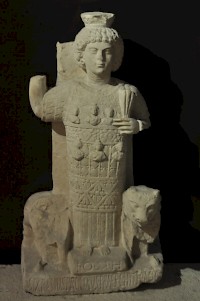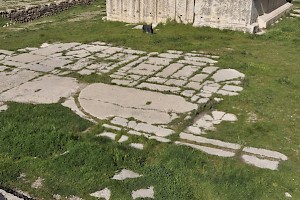Baalbek, Temple of Jupiter
Q21079381Baalbek or Heliopolis (Greek: Ἡλιούπολις, "sun city"): town in the northern Bekaa valley, site of the largest sanctuary in the Roman world.
Temple of Jupiter

The greatest temple of Baalbek was dedicated to a god who was, at various periods in history, called Ba'al, Hadad, Helios, Zeus, or Jupiter Optimus Maximus Heliopolitanus. According to Macrobius, the cult statue had been taken from Egypt, was made of gold, and showed the god as a beardless, young man, "with its right hand raised and holding a whip, like a charioteer," while the left hand held "a lightning bolt, and ears of grain".note

We also know that the statue was flanked by two bulls (Hadad's animal), and that the god wore representations of the Sun and Moon on his breast. On his head, he wore a basket-shaped hat, a kalathos. With so many names and attributes, it is fitting that the god of Heliopolis also embodied several qualities: fertility god, lord of thunder and rain, oracular god, supreme deity. He was also a sun god, which may or may not explain the orientation of the temple, more or less on the east.
The temple, the largest in the Roman world, served as an oracle. In 114 CE, the god predicted the emperor Trajan that he would not return from his expedition against the Parthian Empire.note Macrobius informs us that during a session of the oracle, the statue was placed in a litter; the bearers sort of sensed the divine will and carried it in certain directions, which could be "decoded" by the priests.note A similar practice is known from the oracle of Ammon in Siwa in Egypt.

The Ptolemaic rulers who reigned the Bekaa valley in the third century BCE, may have started the construction of the platform on which the temple of Jupiter was to be build, and construction went on ever since. Work on the shrine itself started in ca. 60 BCE; it was more or less completed during the reign of Nero (r.54-68 CE), and was now world famous.
The emperor Antoninus Pius (r.138-161) initiated the building of the Great Court in front of the temple of Jupiter. The celebrations must have been quite impressive: writing several centuries later, the Antiochene chronicler John Malalas believed Antoninus to have been the builder of all of Heliopolis. Later rulers, like Septimius Severus (r.193-211) and his son Caracalla (r.211-217), added the Propylaea, while the Hexagonal Court was completed by Philip the Arab (r.244-249). It was now one of the largest temples in the world, and certainly the largest in the Roman world.

Like the god who was venerated over here, the complex combined elements from various cultures. For example, the shrine was divided into a sacred room and a "holy of holies", as was customary in the Near East. The worshipers had to stay on the court, where they would have to climb to the roofs of tower-shaped altars, where the sacrifices were performed and the visitors could look inside the shrine and see the cult statue. Similar tower-altars are know from all over the region (e.g., Faqra and Machnaqa). From the Greek tradition are the various architectural elements: the temple was built in the Corinthian style. The expansion, by adding symmetric elements along the axis, reminds one of the temples of Egypt.
After the rise of Christianity, the temple and oracle declined. The emperor Theodosius I (r.378-395) may have closed the temple, while his grandson Theodosius II (r.402-450) appears to have built a basilica on the Great Court. The Hexagonal Court may have been covered with a dome. If this is true, the monument resembled the Basilica of the Holy Sepulcher in Jerusalem, which also combined a basilica with a dome.
According to ps.-Zacharias of Mytilene, the end came in "the year 836" of the Seleucid Era, which is our 524/525. Lightning struck and destroyed the temple.note It is quite ironical that the temple of a lightning god perished in this way. The same author mentions that in his days, the temple had been converted into a church of Mary, mother of God.

The emperor Justinian (r.527-565) removed some granite columns from the ruin and may have used them in the Hagia Sophia in Constantinople. The statement by Michael the Syrian that the cult statue was still standing during the reign of Justin II (r.565-578), cannot be correct.note
Sometime after the Arab conquest, the church in the ancient sanctuary was abandoned, and later, it was even dismantled when, in the age of the Crusades, the giant complex was converted into a fortress. Today, it is still called Qalaa, "fort".